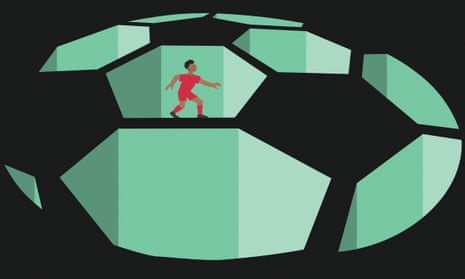At the height of the cold war, the Soviet Union developed a deep institutional suspicion towards denim jeans. Jeans and jean‑related items were seen as an emblem of western‑style decadence, a symbol for the younger generation of intoxicatingly subversive belief in modernism, artistic freedom and comfortable riveted trousers.
There were heavy penalties for those caught up in the trade of blackmarket denim, what the police called “jeans crimes”. But this was a war the authorities always looked like losing. In 1975 prohibition was lifted. The ministry of light industry announced instead that it would start to produce its own approved communist denim, tailored from highest-quality clothing-cardboard and available in a range of superior citizen-fashion styles.
It didn’t work out. Soviet dzhins may have looked like the real thing. But close-up they lacked some vital element of danger and grace, of not falling to pieces in the rain or dyeing your legs blue. Dzhins were ultimately a failure, another front conceded in the ideological struggle, and proof once again that no matter how well-constructed the facsimile, in the end there is no substitute for the real thing.
All of which is a roundabout way of getting on to Alex Oxlade-Chamberlain, an authentically talented English footballer whose mid-career doldrums – 24 and there’s so much more – get a bit more absorbing every week. There is a chance Oxlade-Chamberlain might start his first league game for Liverpool on Saturday at home to Huddersfield. Only a small chance, though, given the surplus of roughly similar midfielders in Jürgen Klopp’s squad and the availability of Georginio Wijnaldum after injury.
Plus, of course, there is something else, too, a quality that has followed Oxlade-Chamberlain from Arsenal, that unavoidable sense of category confusion about a player who has every attribute – brains, skill, speed, athleticism, elite academy education – to be a high-functioning elite footballer; apart from the ability to make any really discernible mark so far as a high‑functioning elite footballer.
Eight years into his senior career the Ox remains the Oxymoron, the most eagerly coveted English midfielder nobody seems to really want in their regular first XI. His progress has remained oddly mixed. Aged 19 he announced himself for Arsenal with a performance in the Champions League against Milan where he ran at a pedigree defence with such craft and poise and skill he has never been able to do it again.
This is a creative, attacking footballer good enough to score a sensational goal against Brazil at the Maracanã, thorough enough to study opponents and other players at home to improve his own tactical fluidity, who still contributed just one Premier League assist between March 2014 and October 2016. A player who seems in outline to be comprised solely of strengths not weaknesses, but who still hasn’t ever quite been able to fit as an inside-forward, wing-back, central playmaker, whatever.
Oxlade-Chamberlain was fast-tracked by Fabio Capello and coveted by Sir Alex Ferguson. He was wanted this summer by Arsenal, Chelsea and Liverpool. He is a genuinely likable man, a team player and model pro, his public presence less like a footballer, more like the friendly junior PE teacher in a BBC children’s drama. And yet this is still a career that has effectively decelerated, failed to thrill, drifted.
There is a theory about the disjunct between the appearance of Oxlade‑Chamberlain and the effect off Oxlade-Chamberlain. The theory goes that he is in effect an elite athlete playing football rather than a “pure” footballer with nothing else in his veins. Oxlade-Chamberlain was a fine junior rugby player and an age-group cricketer good enough to still hold Hampshire district batting records. His old coach reckons he could have made it as a wicketkeeper-batsman, his hands were so good, his hitting so clean.
This is a seriously gifted human being. But at this level he’s a very convincing busker, an all-purpose man‑athlete lacking in nothing but the one thing you really need to be in that elite band, the feeling of oozing football from every clogged and greasy pore.
Compare him with, say, Gabriel Jesus, the wiliest, most football-flavoured 20-year-old imaginable. Or Luka Modric, who you’d hardly pick out of a lineup as a professional athlete, but who stinks of football so powerfully it’s probably hard to get in a lift with him, whose every movement is so shot through with uncut footballing resin he seems to define the limits of the game as he glides about, bouncing along behind the ball like its tethered human counterpart.
Italians talk about being furbo showing a kind of base cunning and guile. In Brazilian football lore they have the malandro, the thief, the trickster, the football sprite. Oxlade-Chamberlain, this theory goes, is not a malandro, is not furbo; lacks in some fundamental sense the madness. He is instead a dzhins footballer, a convincing and effective facsimile.
If this seems a sweeping dismissal of man whose entire life has been spent around football, whose dad and granddad were pros, then what is certain is that Oxlade-Chamberlain represents the acme of a certain elite footballing phenomenon, the top-down academy player. He went to a rugby-playing school. He joined Southampton aged seven. Like every other kid of that age he entered the familiar omerta beyond the park and amateur club scene where the only football played is approved football, managed football.
This idea of technically sound players who lack nothing except a little raggedness has become a new strain of anxiety. From producing players with heart but inadequate basic skills, English football now fears it may be raising mannered, high-grade filler. The under-17s are the latest age group with a shot at winning a title. This will be a part the background neuroses over what next, what now? The sense that what we have here is a generation of command-economy athletes, our own convincing factory version of the real thing.
Like most theories about something as muddled and complex as sport, this is probably a load of bunk too. What is certain is Oxlade-Chamberlain, the Oxymoron, still has six years of unspent prime at a place he turned down a higher basic salary to join. How it goes from here will be quietly fascinating, a test of the basic tension between obvious talent and opportunity, that full blue denim air of authenticity, and the reality of making it count.

